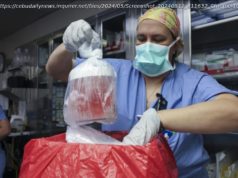The good news: We have an experimental vaccine that can help.
There’s a worrying new Ebola outbreak in the Democratic Republic of the Congo — the second the country has faced since the largest-ever Ebola epidemic swept West Africa from 2014 to 2015.
The World Health Organization learned about the new outbreak on May 8, when DRC health officials reported two confirmed cases of Ebola in Bikoro, a health zone in the country’s northwest Équateur province.
No one knows when or how the outbreak started, but the WHO suspects that since April 4, a total of 44 people have been infected with Ebola (though only three of them are confirmed so far), including 23 deaths. Three of the deaths involved health care workers. The WHO has also identified nearly 400 contacts of Ebola victims who are currently being followed up with.
Health officials suspect that the high case fatality rate means there may be more Ebola cases already out there, and that this outbreak could have been simmering undetected for some time. “If you have [that many] cases that are fatal, that tells me we don’t know how big the iceberg is — that there’s more that have not been detected yet,” said Daniel Bausch, the director of the UK Public Health Rapid Support Team, who has been advising on the outbreak response.
An Ebola outbreak is never good news. But there is some reason not to fear the worst just yet. To start, with the DRC has a long history with Ebola (unlike the West African countries where the 2014 to 2015 outbreak originated). This would be the ninth known Ebola outbreak to strike the DRC, including one that involved five confirmed cases last year and was quickly stamped out. So that means health officials are experienced in spotting the virus and preventing it from spreading.
What’s more, there’s a promising vaccine to prevent Ebola: It hasn’t yet been approved for market, but the WHO and the DRC health ministry are ready to deploy it in the first field test for the vaccine early on in an Ebola outbreak .
On the other hand, as Bausch indicated, the outbreak might be much larger than it seems for now. The Bikoro region is in a pretty remote area of the country, with a population of about 163,000 and little connection by road to more densely populated areas of the country. But it’s also a market town with a port, situated on a lake connecting the highly trafficked Congo and Ubangi rivers. So people with Ebola could be a boat ride to Kinshasa or Brazzaville, the capital of the neighboring Republic of the Congo. And in a potentially game-changing development, on May 17, the WHO reported one confirmed near Mbandaka, an urban area with a population of 1.2 million people 100 miles from Bikoro.
Taken together, this means this DRC outbreak could go either way: be quickly stamped out, or spin into something larger. And if this outbreak becomes bigger, one thing is for sure: America, traditionally a global health leader, isn’t ready for a pandemic right now.
Before diving into the current outbreak more deeply, let’s pause for a quick backgrounder on Ebola. The virus is a hemorrhagic fever that kills many of its victims — but that death rate can be highly variable depending on the resources patients and doctors have access to. That means Ebola tends is deadlier in poorer countries like the DRC than it is in the US or Europe.
To get Ebola, you need to have direct contact with the bodily fluids, like vomit, urine, or blood, of someone who is already sick and has symptoms. When the disease strikes, it’s like the worst and most humiliating flu you could imagine. People get the sweats, along with body aches and pains. Then they start vomiting and having uncontrollable diarrhea. They experience dehydration. These symptoms can appear anywhere between two and 21 days after exposure to the virus. Sometimes patients go into shock. Rarely, they bleed.
In fatal cases, death comes fairly quickly — within a few days or a couple of weeks of getting sick. Survivors return to a normal life after a months-long recovery that can include periods of hair loss, hearing loss, and other sensory changes, weakness, extreme fatigue, headaches, and eye and liver inflammation. In a phenomenon now dubbed ”post-Ebola syndrome,” Ebola, scientists have learned, can continue to live in other parts of the body or bodily fluids, including the eyeballs or semen of survivors, for months after the blood is declared virus-free.
There are five species of Ebola, four of which have caused the disease in humans: Zaire, Sudan, Taï Forest, and Bundibugyo. The fifth, Reston, was discovered in Virginia and has infected only monkeys. The animal host of Ebola is widely believed to be the fruit bat, although scientists haven’t been able to confirm this. The virus seldom makes the leap into humans.
The current outbreak in the DRC involves the Zaire strain, which was discovered in 1976, the year Ebola was first identified in what was then Zaire (now the Democratic Republic of the Congo). That same year, the virus was also discovered in South Sudan.
Since 1976, there have been more than 30 known Ebola outbreaks, including a total of nine in the DRC.
For now, the WHO estimates the risk of Ebola spreading within the DRC is high “due to the nature of the disease and the lack of epidemiological and demographic information to estimate the magnitude of the epidemic.” That means we can expect to see more Ebola cases in the coming days.
“It is too early to judge the extent of this outbreak,” said Peter Salama, WHO deputy director-general for emergency preparedness and response, in a statement last week. “However, early signs including the infection of three health workers, the geographical extent of the outbreak, the proximity to transport routes and population centers, and the number of suspected cases indicate that stopping this outbreak will be a serious challenge.”
The WHO is working with the country’s ministry of health, as well as Doctors Without Borders, to figure out who may have been exposed to Ebola and set up treatment centers where victims of the disease can be cared for and isolated.
Doctors Without Borders, the WHO, GAVI, with the DRC’s health ministry in the lead, will also collaborate on the vaccine program. The plan right now is to start with a ring vaccination approach, which involves inoculating the contacts of people who are infected with Ebola (as well as health professionals and other responders), effectively creating a “ring” of protection around them.
On the home front, health experts have long said the US is underprepared for a pandemic. But right now the situation looks more precarious.
Just one day after DRC’s Ebola outbreak was declared, the head of global health security on the White House’s National Security Council, Rear Adm.






